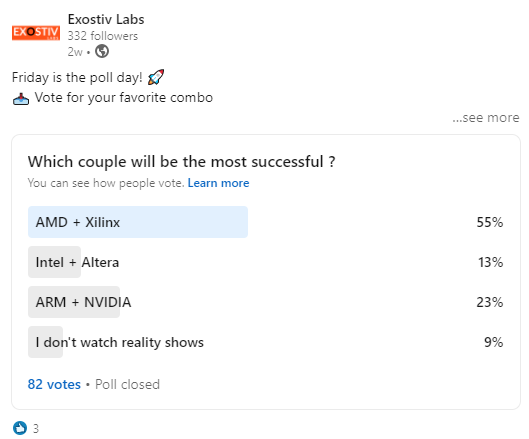
The future of FPGA
Quite unusually, I’d like to share some random thoughts about the evolution of our industry.
It has escaped to no one, these are exciting times, with tech giants scrambling to build the most successful company in computing. As you see with the picture above, we have recently conducted a poll on LinkedIn. As it seems, in April 2021, the AMD + Xilinx couple is seen as the one with the brightest future.
Since everybody that counts in processing seems to want to conquer the data center workloads by associating parallel processing with sequential processing, the little question that lingers in the mind of FPGA engineers (and I know that we are many of them) today is:
Is it the end of the FPGA as we know it?
Don’t get me wrong here. I really see with pleasure the ‘come back’ of custom hardware as a key to resolve the toughest engineering problems. I remember times when we assembled stereotyped series of IPs around the same processor and the software guys were the magicians who gave any SoC the differentiation required to make an original product. (You said ‘boring’?)
Now, we are converging towards 3 ‘giant couples’ (assuming that the AMD / Xilinx and the ARM / NVIDIA transactions happen), all positioned on the data center, AI workloads, AI inference at the edge, heterogeneous workload to go beyond the Moore’s law, parallelism to save power, … and so on. (I know, I know, there are many details and subtleties in it, but please allow me to simplify).
None of this ressembles the ‘old world’ of FPGA – what we used to call ’embedded systems’, which some evolution (and a lot of marketing) has started to call ‘the edge’… (more exciting, isn’t it?).
And there is also the fertile area of ASIC and SoC prototyping with FPGA. This first third of 2021 has still seen the 3 EDA giants come up with a new offering not just in emulation (which does not need FPGAs…), but FPGA-based prototyping.
So the question is… which of the above couple(s) will serve the traditional ‘FPGA market’?
Will they turn their back to it because it represents just a tiny portion of the revenue, when compared to the expected rewards of the datacenter workloads?
Will they leave it to Achronix?
… or will they see how strategic they continue to be and keep a traditional FPGA offering?
As always, thank you for reading.
– Frederic

